The Effect of Sports Rehabilitation on Accelerating Injury Healing and Improving Sporting Output
Wiki Article
Athletic recovery plays a vital role in helping athletes recover from injuries and enhance their overall capability. When athletes get hurt, it can be disheartening and discouraging. However, with the right rehabilitation plan, they can return to their sport stronger and more prepared than before. Athletic rehabilitation focuses on targeted exercises and therapies that target the injured area, aiding to reduce discomfort and regain capability. This procedure not only aids in recovery but also boosts athletic capability by tackling any deficiencies or discrepancies that may have contributed to the trauma.
One of the key components of athletic recovery is the assessment of the injury. A qualified expert, such as a physiotherapy specialist or athletic coach, assesses the athlete's status to identify the most effective course of treatment. This evaluation includes understanding the type of injury, its severity, and how it affects the athlete's capability to compete. By collecting this data, the rehabilitation specialist can create a customized treatment plan that includes workouts, flexibility routines, and methods like cold or warmth treatment. This individualized method ensures that the athlete receives the most effective treatment for their particular requirements.
As sportspeople advance through their rehabilitation, they often engage in various workouts designed to strengthen the damaged area. These exercises may include strength exercises, stretching exercises, and stability training. Strengthening the muscles around the trauma helps to stabilize the articulation and prevent future traumas. Additionally, improving range of motion can improve the range of movement, allowing sportspeople to execute better in their sport. Stability exercises is also crucial, as it assists sportspeople keep balance and coordination, which are critical for peak capability.

Another crucial aspect of athletic rehabilitation is learning. Sportspeople learn about their injuries, the healing procedure, and how to avoid subsequent problems. This knowledge empowers them to take an proactive role in their rehabilitation. Understanding the importance of appropriate preparation and recovery practices, as well as the significance of listening to their physical condition, can assist athletes prevent recurrence of injuries. Furthermore, recovery experts often provide guidance on diet and fluid intake, which are vital for recovery and general sports performance.
In conclusion, athletic rehabilitation is essential original site for sportspeople healing from injuries and working to improve their performance. Through personalized assessment and treatment strategies, sportspeople can regain strength, flexibility, and balance. The learning offered during recovery empowers sportspeople to take control of their recovery and prevent future traumas. By committing effort and energy into athletic recovery, athletes not only recover but also enhance their skills, making them better prepared in their respective activities.